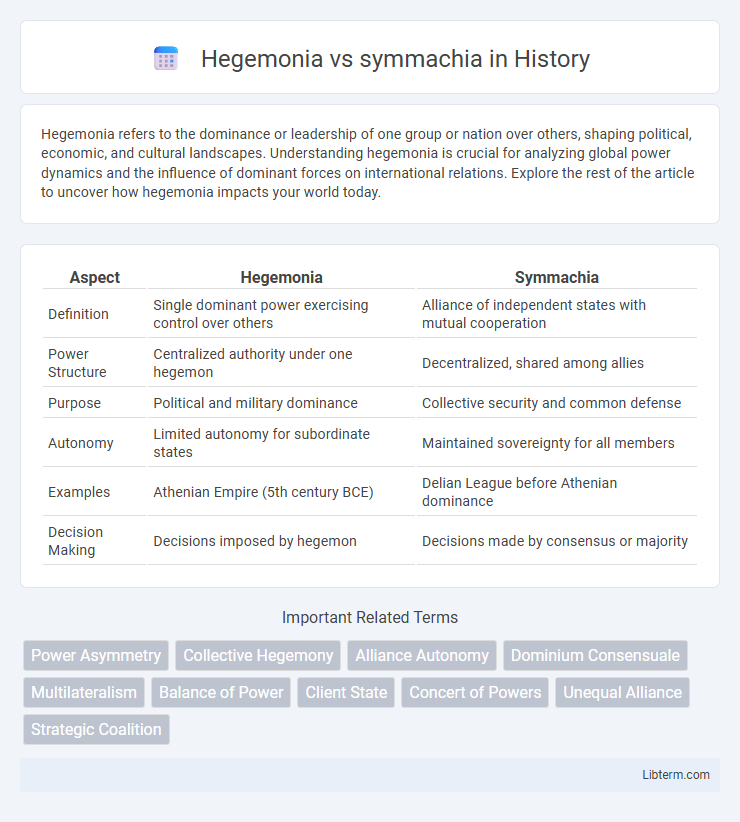Hegemonia refers to the dominance or leadership of one group or nation over others, shaping political, economic, and cultural landscapes. Understanding hegemonia is crucial for analyzing global power dynamics and the influence of dominant forces on international relations. Explore the rest of the article to uncover how hegemonia impacts your world today.
Table of Comparison
| Aspect | Hegemonia | Symmachia |
|---|---|---|
| Definition | Single dominant power exercising control over others | Alliance of independent states with mutual cooperation |
| Power Structure | Centralized authority under one hegemon | Decentralized, shared among allies |
| Purpose | Political and military dominance | Collective security and common defense |
| Autonomy | Limited autonomy for subordinate states | Maintained sovereignty for all members |
| Examples | Athenian Empire (5th century BCE) | Delian League before Athenian dominance |
| Decision Making | Decisions imposed by hegemon | Decisions made by consensus or majority |
Understanding Hegemonia: Definition and Origins
Hegemonia refers to the dominance or leadership of one state or group over others, originating from the Greek word "hegemon," meaning leader or ruler. This concept first gained prominence in ancient Greek political thought, where hegemonic power was established through military strength, economic influence, or political alliances to control or guide other states. Understanding hegemonia involves analyzing its role in shaping international relations, power dynamics, and the formation of empires throughout history.
The Concept of Symmachia: Historical Context
Symmachia, rooted in ancient Greek political structures, signifies a formal alliance or coalition between city-states aimed at mutual defense and shared military objectives. Unlike hegemonia, where one state exerts dominance, symmachia embodies a cooperative framework fostering equality among participants, as seen in classical alliances like the Delian League and the Peloponnesian League. Historical implementations of symmachia reveal its strategic importance in balancing power dynamics and preserving autonomy within volatile geopolitical landscapes of the ancient Mediterranean.
Key Differences Between Hegemonia and Symmachia
Hegemonia refers to dominance or leadership by one state or group over others, often exercising control through political, economic, or military means. Symmachia denotes an alliance or coalition formed by multiple states or groups for mutual defense or benefit, emphasizing equality and cooperation among members. The key difference lies in Hegemonia's hierarchical power structure versus Symmachia's collaborative and balanced partnership.
Ancient Greece: Case Studies of Hegemony and Alliances
Hegemonia in Ancient Greece often involved dominant city-states like Athens exerting control over others through leagues such as the Delian League, leveraging military and economic power to maintain supremacy. Symmachia refers to more balanced alliances such as the Peloponnesian League, where member states retained autonomy while cooperating for mutual defense against common threats like Sparta or Persia. Case studies highlight how hegemonic dominance frequently led to conflicts and tensions within alliances, contrasting with symmachia's emphasis on equal partnership and shared interests.
Political Power Dynamics in Hegemonia
Hegemonia centralizes political power through dominance and control over subordinate states, establishing a hierarchical structure in international relations. In contrast, Symmachia represents alliances based on equal partnerships and mutual defense agreements, emphasizing cooperation over supremacy. The dynamics of political power in Hegemonia reveal strategies of influence and coercion to maintain authority and enforce compliance among weaker entities.
Decision-Making and Collective Action in Symmachia
Symmachia emphasizes collective decision-making through consensus among member states, ensuring equal participation in policy formulation and strategic planning. Unlike Hegemonia, where dominant powers wield centralized authority, Symmachia distributes power more evenly, fostering collaborative governance and mutual respect. This decentralized approach enhances cooperative action, aligning interests to achieve shared security and common goals effectively.
Benefits and Drawbacks of Hegemonic Leadership
Hegemonic leadership centralizes power and decision-making within a dominant group, allowing for swift policy implementation and unified direction, which can enhance organizational efficiency and strategic coherence. However, this concentration of authority often suppresses dissent and limits diverse input, potentially leading to resistance, reduced creativity, and ethical concerns. The imbalance of power in hegemonic systems risks alienating subordinate groups and undermining long-term stability compared to the more collaborative and inclusive approach found in symmachia alliances.
Symmachia’s Role in Balancing Power Structures
Symmachia functions as a coalition system that distributes power by uniting multiple states or groups under a collective agreement, thereby preventing any single entity from dominating the political landscape. This alliance mechanism ensures stability through shared responsibilities and mutual defense commitments, effectively counterbalancing hegemonic ambitions. By fostering cooperation among diverse actors, symmachia maintains equilibrium in international relations and deters unilateral control.
Modern Reflections: Hegemonia vs Symmachia in Contemporary Politics
Modern reflections on hegemonia versus symmachia in contemporary politics reveal a stark contrast between unilateral dominance and cooperative alliances. Hegemonia emphasizes centralized power, often seen in superpowers exerting influence through economic or military means, while symmachia highlights multilateral partnerships and collective security frameworks such as NATO or the European Union. The dynamic interplay between these models shapes global diplomacy, impacting international stability and the balance of power in the 21st century.
Lessons Learned: Strategic Insights from Ancient Models
Analysis of hegemonia versus symmachia reveals crucial strategic insights, emphasizing centralized control versus coalition-building for power consolidation. Hegemonia models demonstrate the effectiveness of singular leadership in enforcing uniform policies and rapid decision-making during conflict. In contrast, symmachia underscores the value of alliance flexibility, shared resources, and diversified military capabilities to enhance resilience against common threats.
Hegemonia Infographic

 libterm.com
libterm.com